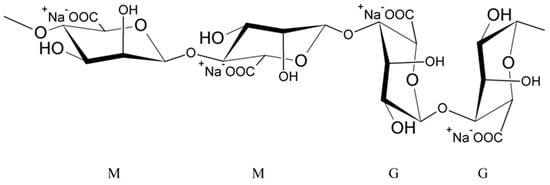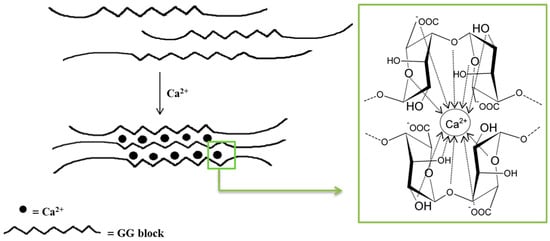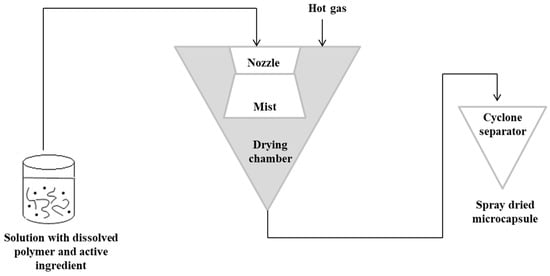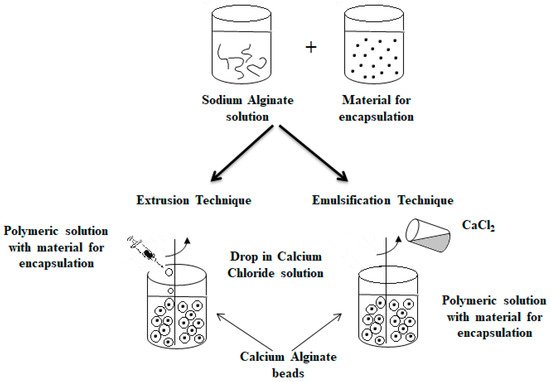Alginiates are the most widely used ny to najczęściej stosowane polimery natural polymers in the phne w przemyśle farmaceutical, food and cosmetic industries. Usually, they are applied as a thickening, gel-forming and ycznym, spożywczym i kosmetycznym. Zwykle stosuje się je jako środek zagęszczający, żelujący i stabilizing agent. Moreover, thujący. Ponadto jako systemy dostarczania często stosuje się preparaty na bazie alginate-based formulations such as matricesianu, takie jak matryce, membranesy, nanospheres or microcapsules are often used as delivery systems. Alginate microparticlesfery lub mikrokapsułki. Mikrocząstki alginianu (AMP) are biocompatiblto biokompatybilne, biodegradable and nontoxic carriers, applied to encapsulateowalne i nietoksyczne nośniki stosowane do kapsułkowania hydrophilic active filowych substances, includingji czynnych, w tym probioticsyków.
- alginate
- microparticles
- active substances
- probiotics
1. InWstroductionęp
2. Alginate cCharacteristicskterystyka alginatu
Alginates are natural polysaccharides, polyanionic polymers, obtained from marine algae [35][36][35,36], usually from three species of marine brown algae, Phaeophyceae: Macrocystis pyrifera, Laminaria digitata and Laminaria saccharina. The structure of alginates depends on the source of the sea algae, i.e., its species, geographic origin, or seasonal varieties [37]. Alginates are unbranched copolymers of D-Mannuronic acid (M block) and L-Guluronic acid (G block) linked by β (1–4) glycosidic bonds [37][38][39][40][41][42][43][37,38,39,40,41,42,43]. These blocks are arranged in an irregular block pattern with different GG, MM and MG block proportions (Figure 1) [30][35][37][38][42][30,35,37,38,42]. Blocks M and G are placed in the different locations along the chain (e.g., MMMM, GGGG, MMGG, GMGM) and in various amounts [38].
Cross-Linking of Alginates
Monovalent metal ions with alginates form soluble salts, while divalent and multivalent cations (except Mg2+) form gels or precipitate. The affinity of alginates to various cations and selective ion binding are the basis of the alginates’ ability to form hydrogels. Alginates containing a large number of guluronic acid blocks form gels with much greater strength compared with mannuronate-rich alginates because G blocks have a stronger affinity with divalent ions than M blocks [35]. The interaction of alginates with divalent cations, which are in particular calcium cations, leads to the formation of biodegradable gels [38]. Polymerization is based on the cross-linking of copolymers through ionic bonds between Ca2+ cations and alginate anions [38][44][38,44]. Each Na+ cation ionically binds to only one carboxyl group of the alginate chain, while the Ca2+ cation interacts with two carboxyl groups that come from different polymer chains. The exchange of Na+ ions into Ca2+ ions is relatively easy and takes place when an aqueous solution of sodium alginate is mixed with a solution containing calcium ions [41]. The mechanical properties of the formed gels are determined by both the concentration of divalent ions and the alginic acid salts in the reaction mixture [38][44][38,44]. The distinctive molecular structure resulting from these interactions is referred to as the “egg–box” model (Figure 2) [38][44][45][46][38,44,45,46]. It should be underlined that only the G blocks take part in the cross-linking process. The homopolymers of G blocks form ordered, three-dimensional regions wherein Ca2+ ions are embedded like eggs in a cardboard box [47].
3. Alginate Encapsulation Techniques
Generally, microencapsulation techniques are classified into three groups [61][62][63][61,62,63]:- (a)
-
Physical methods such as spray drying, extrusion, lyophilization, supercritical fluid precipitation and solvent evaporation;
- (b)
-
Physico-chemical methods including coacervation, liposomes and ionic gelation;
- (c)
-
Chemical methods such as interfacial polymerization and molecular inclusion complexation.
3.1. Spray-Drying Technique
The spray-drying technique is the oldest technique used in alginate capsules. The concept of this method was first described in Samuel Percy’s patent in 1872 [64]. The process was introduced commercially in the 1920s, but spray drying was fully applied on a large scale in the early 1980s [65][66][65,66]. In this method, initially, a solution containing the active ingredient should be prepared with the dissolved polymer matrix. The solution is then pressurized and sprayed to form a “mist” in the drying chamber. Hot gas (air or nitrogen) is also blown into the drying chamber. The hot gas makes it possible to evaporate the solvent. The capsules are then transported to a cyclone separator for recovery [3]. In this technique, the control of the product’s feed, gas flow and temperature is important [67][68][67,68]. Figure 3 shows a schematic representation of the spray-drying procedure [3][63][3,63].The spray-drying technique is applicable to encapsulate different kind of actives. Among substances encapsulated in alginate capsules, there were lipids [69] and hydrocarbons such as cellulase [70], carvacrol [71], or insulin [72]. Unfortunately, the main disadvantage of this method is the impossibility to encapsulate substances sensitive to elevated temperature and pressure. Figure 3. Scheme of the spray-drying encapsulation technique.
Figure 3. Scheme of the spray-drying encapsulation technique.3.2. Extrusion Technique
Another technique that has been used for a long time for producing microparticles is the extrusion technique [73]. It consists of the preparation of a hydrocolloid solution (an aqueous dispersion of a natural or synthetic polymer), e.g., sodium alginate. Then, the material for encapsulation is added to the solution, and the suspension is pressed into droplets into the gelling or hardener solution, e.g., calcium chloride [3][30][39][49][67][74][75][76][77][3,30,39,49,67,74,75,76,77]. Depending on the scale (laboratory or pilot scale), a syringe needle or an extruder is used for the process, respectively [39]. The size and shape of the obtained beads depend on factors such as the diameter of the needle and the distance of the needle from the hardener solution. This technique is the most popular in laboratory scale because of simplicity and low cost of production [78]. However, the main limitation in the case of its application in the large scale is the fact that microparticles are formed slowly [30].3.3. Emulsification Technique
An alternative method commonly used to obtain alginate capsules is emulsification. The emulsification technique is more expensive than the extrusion method because a large amount of oil is needed to prepare the emulsion [79]. In this technique, the discontinuous phase (mixture of hydrocolloid and encapsulated material) is added to a large volume of continuous oil phase oil [3][30][39][46][49][67][3,30,39,46,49,67]. In the case of food applications, vegetable oils are used as a continuous phase, most often canola, sunflower or corn oils [78][80][78,80]. Additionally, to stabilize the droplets of the internal phase, an emulsifier should be added to the mixture formed. The obtained water-in-oil emulsion is continuously homogenized by stirring [3][30][39][49][67][3,30,39,49,67]. The speed of the emulsion mixing is a critical step because it affects both the shape and size of the capsules formed [81]. Very large capsules (around 1000 μm in diameter or larger) can result in poorly coated structures and a coarse texture [82], which in turn affects the dispersion quality of the capsules in the final product [79]. The final emulsion containing alginate droplets is broken by adding calcium chloride solution and centrifuged, thereby separating the oil and water phases to obtain microspheres [83][84][83,84]. Figure 4 shows a diagram of the encapsulation process using extrusion and emulsification techniques [46][67][46,67].The main difference between the two techniques is the sequence of combining the alginate and calcium chloride solutions. The polymer solution containing the active ingredient is introduced into the calcium chloride solution in the case of the extrusion technique as opposed to the emulsification technique, where the CaCl2 solution is dripped into the polymer solution. Depending on the method used to obtain them, the calcium alginate beads are called balls (gelled droplets obtained by extrusion technique) or capsules, in the case of the products of the emulsification technique [85]. The main differences between these alginate beads are listed below [49][78][85][86][49,78,85,86]: Figure 4. Scheme of the encapsulation process by extrusion (on the (left)) and by emulsification technique (on the (right)).
Figure 4. Scheme of the encapsulation process by extrusion (on the (left)) and by emulsification technique (on the (right)).-
The balls have a porous network, while the capsules have a liquid core (water or oil);
-
The dimensions of the balls are much larger than in the case of the capsules;
-
The balls are uniform in size and shape in contrast to differing in size in capsules.
ThDane data presented inprzedstawione w Ttableeli 1 i wskazują, że obecndicate that the currently used alginate encie stosowane techniki enkapsulation techniques are not universal. All methods have some pros and cons, but among the others, the emulsification is more universal. The method allows to obtain small microparticles, containing both hydrophilic andcji alginianowej nie są uniwersalne. Wszystkie metody mają swoje plusy i minusy, ale między innymi emulgacja jest bardziej uniwersalna. Metoda pozwala na otrzymanie małych mikrocząstek, zawierających zarówno składniki hydrofilowe, jak i hydrophobic ingredients with high fobowe o wysokiej wydajności process efficiency. Moreover, the microencu. Ponadto mikroenkapsulation of alginates based on thcja alginianów oparta na technice emulsification technique could be modified by differing the polymer gelling processgowania może być modyfikowana przez zróżnicowanie procesu żelowania polimerów.Table 1. Advantages and disadvantages of alginate microencapsulation methods [3][79][84][88][89][90][3,79,84,88,89,90].Method Advantages Disadvantages Extrusion - -
-
simple and cheap method
- -
-
no use of harmful solvents
- -
-
no use of large amounts of oil and emulsifier
- -
-
in the case of probiotics, no damage to the probiotic cell and high viability
- -
-
slow formation of microparticles → a problem in a large-scale application
- -
-
limited choice of encapsulated actives
Emulsification - -
-
the possibility of encapsulating both hydrophilic and hydrophobic ingredients
- -
-
high process efficiency
- -
-
the possibility of obtaining smaller microparticles than in extrusion and spray drying methods
- -
-
easy to scale up and fewer restrictions on preparation devices
- -
-
high survival rate of probiotics
- -
-
higher costs than in the case of extrusion due to the use of a large amount of oil and emulsifier
- -
-
toxicity of organic solvents and droplet agglomeration due to solvent removal in the case of microcapsules formed from a complex at the interface of emulsion droplets
Spray-drying - -
-
low cost
- -
-
high efficiency and quality of the obtained microparticles
- -
-
adaptable to most typical industrial devices
- -
-
nonuniform capsules
- -
-
material losses due to the adherence of substance particles to the drying chamber
- -
-
limitations in the choice of coating material
- -
-
in the case of probiotics, the loss of viability due to the high-temperature drying requirement
